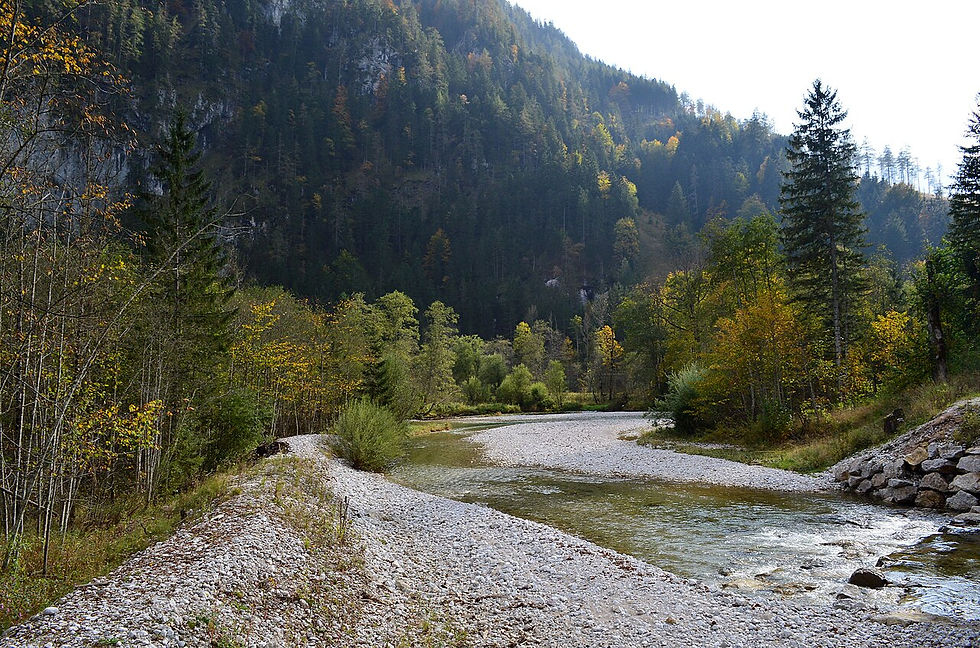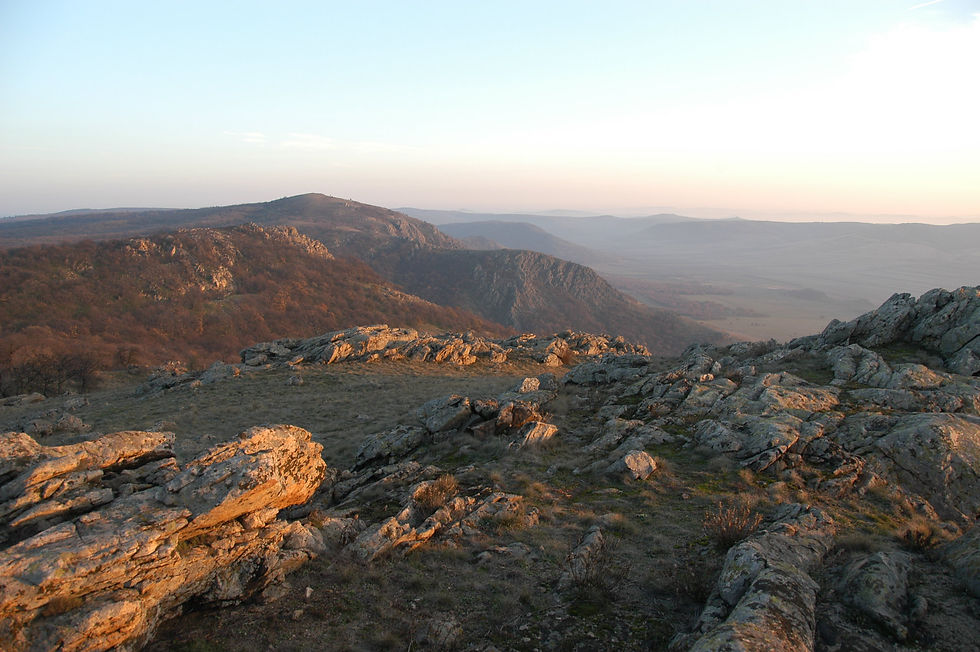Discover Austria and Explore the Geodiversity of the Styrian Eisenwurzan UNESCO Global Geopark
- Wayne Munday
- Aug 23
- 6 min read
Updated: Sep 10
Sip back and discover Austria and explore the Styrian Eisenwurzen UNESCO Global Geopark. The Styrian Eisenwurzen UNESCO Global Geopark was designated in 2015 and is Austria’s largest nature park in the region of northern Styria within the Northern Calcareous Alps of the Eastern Alps. The geopark covers about 574 square kilometers stretching across the municipalities of Altenmarkt, Landl, Sankt Gallen and Wildalpen. This regions dramatic landscape of mountains, broad valleys, deep gorges and extensive forests has been shaped by tectonic forces, glaciation and karst processes. Styria is geologically renowned for its Mesozoic limestones and dolomites, which preserve a rich fossil record as well as striking karst features including caves, springs, river terraces along with and Ice Age moraines. The area is also rich in the mineral Gypsum a sulfate mineral composed commonly formed from evaporating seawater or saline lake environments. At the heart of the geopark lies the Gams Basin an area of global importance preserving rock from the Anisian Stage of the Middle Triassic up to the Cretaceous–Paleogene Boundary (K/Pg) recording one of Earth’s greatest extinction events. Fossils are found within the Nierental and Zwieselalm formations of the Gosau Group and represents a deep-water environment characterised evidence of turbidites, slump beds and mass flows yielding abundant fossils such as corals, ammonites, rudists, bivalves, gastropods, foraminifera, algae and bryozoa. The limestone of the Styrian Eisenwurzen UNESCO Global Geopark is a vital source for the supply of high-quality drinking water to Vienna.

During the Middle Triassic Epoch between 247.2 - 241.5 million years ago the area now occupied by the Styrian Eisenwurzen UNESCO Global Geopark was a shallow tropical sea, where extensive carbonate platforms accumulated forming the thick limestones and dolomites that dominate the landscape today. The Gams Valley was a warm and restricted lagoon that experienced intense evaporation causing calcium and sulfate ions to precipitate as gypsum and was deposited alongside limestones and dolomites. These Triassic deposits were later folded and uplifted during the Alpine orogeny as the African and European plates collided exposing gypsum at the surface and creating caves through karst processes. The region is globally significant as the type locality of the Anisian Stage. Subsequent glacial activity further shaped the landscape producing the complex, rugged landscapes of the Northern Calcareous Alps visible today.
The Styrian Eisenwurzen Geopark is renowned for its diverse fossil record including corals, ammonites, snails, bivalves and the distinctive reef-forming rudists that played a key role in ancient marine ecosystems.

The Gosau Group in the Gams Basin has yielded, for the first time, an upper Maastrichtian cephalopod fauna, including Angulithes sp., Hauericeras sp., Pachydiscus (P.) gollevillensis, Glyptoxoceras cf. rugatum, and Neancyloceras bipunctatum. The presence of Pachydiscus (P.) gollevillensis confirms a Late Maastrichtian age between 68.1 - 66.0 million years ago.
Positioned at the eastern edge of the Northern Limestone Alps the geopark is framed by the Alpine landscape of the Salza River. This part of Austria is elemental with limestone peaks towering above valleys shaped by glaciers and streams and their slopes are blanketed in spruce and beech forests. Despite its rugged character of the geopark it is accessible from the larger gateway towns of Liezen and Mariazell making it an inviting destination for eco-tourists eager to immerse themselves in landscapes where both nature and culture remain vivid and authentic.

Visitors can explore the GeoDorf Gams or “Geo Village Gams,” that serves as the educational and geological hub of the Styrian Eisenwurzen UNESCO Global Geopark, offering visitors an engaging gateway into 250 million years of Earth’s history. Located in the Alpine village of Gams the center combines immersive experiences with hands-on learning to make geology accessible for all ages.
Highlights include the GeoRama, where interactive displays guide visitors through ancient tropical seas, the Alpine orogeny, and the Ice Age; the GeoWerkstatt, a workshop where guests can handle and even uncover their own fossils with expert guidance; and the GeoPfad, a scenic 3-kilometer trail marked by 15 interpretive stations that reveal the area’s geological heritage.

Other attractions, such as the Kraus Cave (Kraushöhle) a gypsum-bearing cave known for being the first cave in the world to be opened to the public with electric lighting in 1892. Before arriving at the Kraus Cave visitors will have the treat of passing through the 700-meter-long Nothklamm Gorge preserving numerous fossils of sea lilies. The gorge features a series of well-secured wooden footbridges and steps that wind along the Gamsbach stream leading to both the Kraushöhle cave and an ancient stone ball mill.

The tectonic upheavals of the Alpine orogeny that began around 65 million years ago thrust these rocks skyward creating the steep mountain ridges and folded strata visible today. Along the way, karst processes and the dissolution of the limestone by water carved spectacular features such as caves, sinkholes and waterfalls.

Among the most spectacular areas of karst scenery is the Wildalpen where rivers and the Wasserlochklamm waterfalls cascade and vanish into underground channels before re-emerging in turquoise springs. The Arzberg Cave in Wildalpen has yielded the remains of the large and now extinct cave bear Ursus spelaeus as well as other artifacts with some specimens dating back to the Late Pleistocene over 30,000 years ago.

This area is underlain by limestone, dolomite and metamorphic carbonates that are highly susceptible to dissolution and karst development. While classic karst landforms like extensive sinkholes are less prominent here, Wildalpen is better known for its dramatic gorges, caves and springs. Among its most distinctive natural wonders are the Spitzenbach Gorge also called the “valley of butterflies” for its rich biodiversity and the Wasserloch Gorge famous for its narrow canyons, waterfalls, and sweeping views.
Springs fed by karst aquifers are another defining feature, underscoring the importance of Austria’s karst regions, which together provide around 50% of the nation’s drinking water. Additional points of interest include the Gansergrotte a small cave once quarried for millstones.
The diversity of landscapes within the geopark nurtures an equally rich diversity of life. Steep cliffs and alpine pastures alternate with river valleys creating habitats that shift dramatically with altitude and geology. Calcareous soils on limestone outcrops host rare plants such as Edelweiss, Alpine Asters and Orchids are adapted to the thin alkaline ground. Forests are dominated by Beech and Spruce but in higher zones both Larch and Mountain Pine often find themselves clinging tenaciously to rocky slopes.

The Salza River is celebrated as one of Austria’s cleanest rivers. Its gravel banks shelter diverse invertebrates and serve as nesting sites for common sandpipers and little ringed plovers while its crystal-clear waters sustain Brown Trout, Grayling and even Eurasian Otter (Lutra lutra) have been re-established. The rivers rapids and meanders create rich wetland habitats where Kingfishers, Dippers and Herons to thrive.

Wildlife enthusiasts visiting the area are rewarded with frequent encounter early mornings may reveal Red Deer grazing in meadows or Chamois nimbly scaling rocky cliffs and Alpine meadows and birdwatchers can often spot Golden Eagles and Peregrine Falcons soaring high patrolling above the valleys. The karst caves is home to bast, cave beetles and other species adapted to the dark subterranean worlds.

Human history in the Eisenwurzen is inseparable from its natural resources. The very name “Eisenwurzen” refers to "iron production" which flourished here from medieval times into the modern era. Ore mined in surrounding mountains was smelted in the valleys fueling a thriving iron industry and local economy.
Today, museums such as the Museum HochQuellenWasser Wildalpen tell a fascinating history behind the construction and operation of the Second Vienna High Spring Water Pipeline and nearby waterfalls of the Kläfferquelle one of the main sources of high-quality drinking water supplying Vienna.
The Styrian Eisenwurzen UNESCO Global Geopark is more than a breathtaking destination in Austria—it is a living museum of Earth’s history, culture, and biodiversity. From the Triassic seas that deposited its limestones, dolomites, and gypsum, to the dramatic mountain-building of the Alpine orogeny, this geopark preserves a geological archive spanning over 250 million years. Visitors can explore world-class sites such as the Gams Basin, type locality of the Anisian Stage, gypsum caves like Kraushöhle, and the glacial valleys and waterfalls of Wildalpen. Its diverse fossil record from ammonites and rudists to corals makes the geopark a global reference point for palaeontology and stratigraphy. Beyond geology, the region offers pristine rivers, karst springs, rare alpine flora, and abundant wildlife, alongside a cultural legacy shaped by centuries of iron production and water management. Whether you are a geotourist, hiker, fossil enthusiast, or eco-traveller, the Styrian Eisenwurzen Geopark invites you to experience the harmony of nature, history, and science in one of Austria’s most authentic and elemental landscapes.








